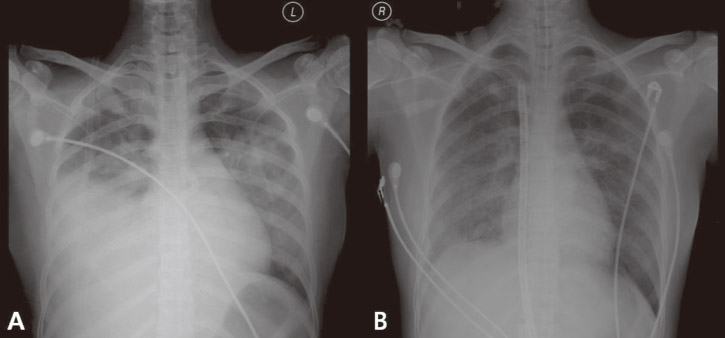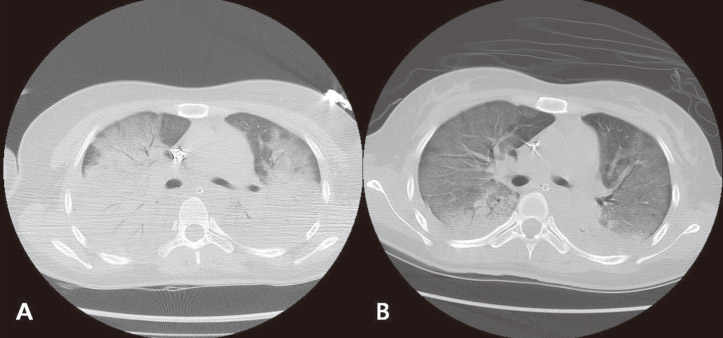Infect Chemother.
2010 Apr;42(2):122-126.
Early Extracorporeal Membrane Oxygenation in a Patient with Pandemic Influenza (H1N1 2009) and Acute Respiratory Distress Syndrome
- Affiliations
-
- 1Department of Cardiothoracic surgery, Kangwon National University Hospital, Kangwon National University College of Medicine, Chuncheon, Korea.
- 2Department of Internal Medicine, Kangwon National University Hospital, Kangwon National University College of Medicine, Chuncheon, Korea. wsoh@kangwon.ac.kr
- 3Department of Laboratory Medicine, Kangwon National University Hospital, Kangwon National University College of Medicine, Chuncheon, Korea.
- 4Department of Emergency Medicine, Kangwon National University Hospital, Kangwon National University College of Medicine, Chuncheon, Korea.
Abstract
- Despite advanced technologies in intensive care, pandemic influenza (H1N1 2009) can rapidly progress to acute respiratory distress syndrome (ARDS) and cause death in a small subset of patients. Extracorporeal membrane oxygenation (ECMO) is expected to provide adequate gas exchange, to reduce ventilator-induced lung injury and, eventually, to improve outcome in these patients. A previously healthy, young female received mechanically ventilatory support because of rapidly progressive respiratory failure caused by 2009 H1N1 influenza. As she failed to respond to high ventilatory support, ECMO was instituted at 6 hours after admission. We describe detailed course of case and literature review on ECMO, helping physicians make a decision to initiate ECMO in patients with influenza-related ARDS.
Keyword
MeSH Terms
Figure
Reference
-
1. Perez-Padilla R, de la Rosa-Zamboni D, Ponce de Leon S, Hernandez M, Quiñones-Falconi F, Bautista E, Ramirez-Venegas A, Rojas-Serrano J, Ormsby CE, Corrales A, Higuera A, Mondragon E, Cordova-Villalobos JA. INER Working Group on Influenza. neumonia and respiratory failure from swine-origin influenza A (H1N1) in Mexico. N Engl J Med. 2009. 361:680–689.
Article2. Zapol WM, Snider MT, Hill JD, Fallat RJ, Bartlett RH, Edmunds LH, Morris AH, Peirce EC 2nd, Thomas AN, Proctor HJ, Drinker PA, Pratt PC, Bagniewski A, Miller RG Jr. Extracorporeal membrane oxygenation in severe acute respiratory failure. A randomized prospective study. JAMA. 1979. 242:2193–2196.
Article3. Morris AH, Wallace CJ, Menlove RL, Clemmer TP, Orme JF Jr, Weaver LK, Dean NC, Thomas F, East TD, Pace NL. Randomized clinical trial of pressure-controlled inverse ratio ventilation and extracorporeal CO2 removal for adult respiratory distress syndrome. Am J Respir Crit Care Med. 1994. 149:295–305.
Article4. Freed DH, Henzler D, White CW, Fowler R, Zarychanski R, Hutchison J, Arora RC, Manji RA, Legare JF, Drews T, Veroukis S, Kesselman M, Guerguerian AM, Kumar A. the Canadian Critical Care Trials Group. Extracorporeal lung support for patients who had severe respiratory failure secondary to influenza A (H1N1) 2009 infection in Canada. Can J Anaesth. 2010. 57:240–247. [Epub ahead of print].
Article5. Kumar A, Zarychanski R, Pinto R, Cook DJ, Marshall J, Lacroix J, Stelfox T, Bagshaw S, Choong K, Lamontagne F, Turgeon AF, Lapinsky S, Ahern SP, Smith O, Siddiqui F, Jouvet P, Khwaja K, McIntyre L, Menon K, Hutchison J, Hornstein D, Joffe A, Lauzier F, Singh J, Karachi T, Wiebe K, Olafson K, Ramsey C, Sharma S, Dodek P, Meade M, Hall R, Fowler RA. Canadian Critical Care Trials Group H1N1 Collaborative. Critically ill patients with 2009 influenza A(H1N1) infection in Canada. JAMA. 2009. 302:1872–1879.
Article6. Jain S, Kamimoto L, Bramley AM, Schmitz AM, Benoit SR, Louie J, Sugerman DE, Druckenmiller JK, Ritger KA, Chugh R, Jasuja S, Deutscher M, Chen S, Walker JD, Duchin JS, Lett S, Soliva S, Wells EV, Swerdlow D, Uyeki TM, Fiore AE, Olsen SJ, Fry AM, Bridges CB, Finelli L. 2009 Pandemic Influenza A (H1N1) Virus Hospitalizations Investigation Team. Hospitalized patients with 2009 H1N1 influenza in the United States, April-June 2009. N Engl J Med. 2009. 361:1935–1944.
Article7. Echevarría-Zuno S, Meja-Aranguré JM, Mar-Obeso AJ, Grajales-Muñiz C, Robles-Pérez E, González-León M, Ortega-Alvarez MC, Gonzalez-Bonilla C, Rascón-Pacheco RA, Borja-Aburto VH. Infection and death from influenza A H1N1 virus in Mexico: a retrospective analysis. Lancet. 2009. 374:2072–2079.
Article8. Brun-Buisson C, Minelli C, Bertolini G, Brazzi L, Pimentel J, Lewandowski K, Bion J, Romand JA, Villar J, Thorsteinsson A, Damas P, Armaganidis A, Lemaire F. ALIVE Study Group. Epidemiology and outcome of acute lung injury in European intensive care units. Results from the ALIVE study. Intensive Care Med. 2004. 30:51–61.
Article9. Peek GJ, Mugford M, Tiruvoipati R, Wilson A, Allen E, Thalanany MM, Hibbert CL, Truesdale A, Clemens F, Cooper N, Firmin RK, Elbourne D. CESAR trial collaboration. Efficacy and economic assessment of conventional ventilatory support versus extracorporeal membrane oxygenation for severe adult respiratory failure (CESAR): a multicentre randomised controlled trial. Lancet. 2009. 374:1351–1363.
Article10. Davies A, Jones D, Bailey M, Beca J, Bellomo R, Blackwell N, Forrest P, Gattas D, Granger E, Herkes R, Jackson A, McGuinness S, Nair P, Pellegrino V, Pettil V, Plunkett B, Pye R, Torzillo P, Webb S, Wilson M, Ziegenfuss M. Australia and New Zealand Extracorporeal Membrane Oxygenation (ANZ ECMO) Influenza Investigators. Extracorporeal membrane oxygenation for 2009 influenza A(H1N1) acute respiratory distress syndrome. JAMA. 2009. 302:1888–1895.
Article11. Conrad SA, Rycus PT, Dalton H. Extracorporeal Life Support Registry Report 2004. ASAIO J. 2005. 51:4–10.
Article12. Lewandowski K. Extracorporeal membrane oxygenation for severe acute respiratory failure. Crit Care. 2000. 4:156–168.
- Full Text Links
- Actions
-
Cited
- CITED
-
- Close
- Share
- Similar articles
-
- 2009 H1N1 influenza virus infection and necrotizing pneumonia treated with extracorporeal membrane oxygenation
- A Fetal Case of Pandemic Influenza (H1N1 2009) by the Aggravated Heart Faiure
- A Fatal Case in Pregnant Woman Infected by H1N1 2009 in Korea
- The Treatment of Adult Respiratory Distress Syndrome (ARDS) Using Extracorporeal Membrane Oxygenation (ECMO)
- Two Cases of Seasonal Influenza Virus (H3N2) and Acute Respiratory Distress Syndrome



